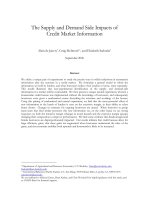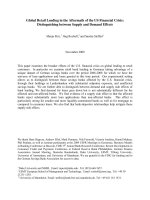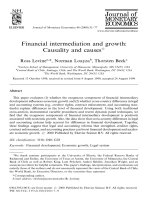Supply and Demand potx
Bạn đang xem bản rút gọn của tài liệu. Xem và tải ngay bản đầy đủ của tài liệu tại đây (267.13 KB, 71 trang )
© 2003 McGraw-Hill Ryerson Limited
Supply and Demand
Supply and Demand
Chapter 4
Chapter 4
© 2003 McGraw-Hill Ryerson Limited
Laugher Curve
Laugher Curve
Teach a parrot the terms of supply and
demand and you’ve got an economist.
Thomas Carlyle
© 2003 McGraw-Hill Ryerson Limited
Demand
Demand
◆
Demand means a willingness and
capacity to pay.
© 2003 McGraw-Hill Ryerson Limited
Demand
Demand
◆
Prices are the tool by which the market
coordinates individual desires.
© 2003 McGraw-Hill Ryerson Limited
The Law of Demand
The Law of Demand
◆
Quantity demanded rises as price falls,
other things constant.
◆
Quantity demanded falls as price rises,
other things constant.
●
© 2003 McGraw-Hill Ryerson Limited
The Law of Demand
The Law of Demand
◆
What accounts for the law of demand?
◆
People tend to substitute other goods
for goods whose price has increased.
© 2003 McGraw-Hill Ryerson Limited
The Demand Curve
The Demand Curve
◆
The demand curve is the graphic
representation of the relationship
between price and quantity demanded.
◆
The demand curve slopes downward
and to the right.
●
!
!
© 2003 McGraw-Hill Ryerson Limited
"
The Demand Curve
The Demand Curve
◆
The negative slope tells us that quantity
demanded varies indirectly—in the
opposite direction—with price.
© 2003 McGraw-Hill Ryerson Limited
#
Other Things Constant
Other Things Constant
◆
“Other things constant” in our definition
of demand means that all other factors
that affect the analysis are assumed to
remain constant, whether they actually
remain constant or not.
◆
These factors may include changing
tastes, prices of other goods, even the
weather.
© 2003 McGraw-Hill Ryerson Limited
$%
D
Price (per unit)
0
Quantity demanded (per unit of time)
P
A
Q
A
A
A Sample Demand
A Sample Demand
Curve,
Curve,
Fig. 4-1, p 84
Fig. 4-1, p 84
© 2003 McGraw-Hill Ryerson Limited
$$
Shifts in Demand
Shifts in Demand
Versus Movements
Versus Movements
Along a Demand Curve
Along a Demand Curve
◆
Demand refers to a schedule of
quantities of a good that will be bought
per unit of time at various prices, other
things constant.
◆
Graphically, it refers to the entire
demand curve.
© 2003 McGraw-Hill Ryerson Limited
$
Shifts in Demand
Shifts in Demand
Versus Movements
Versus Movements
Along a Demand Curve
Along a Demand Curve
◆
Quantity demanded refers to a specific
amount that will be demanded per unit of time
at a specific price, other things constant.
◆
Graphically, it refers to a specific point on the
demand curve.
© 2003 McGraw-Hill Ryerson Limited
$
Shifts in Demand
Shifts in Demand
Versus Movements
Versus Movements
Along a Demand Curve
Along a Demand Curve
◆
A movement along a demand curve is
the graphical representation of the
effect of a change in price on the
quantity demanded.
© 2003 McGraw-Hill Ryerson Limited
$
Shifts in Demand
Shifts in Demand
Versus Movements
Versus Movements
Along a Demand Curve
Along a Demand Curve
◆
A shift in demand is the graphical
representation of the effect of anything
other than price on demand.
◆
The original curve will move to the right
or to the left.
© 2003 McGraw-Hill Ryerson Limited
$
Change in Quantity
Change in Quantity
Demanded
Demanded
Fig. 4-2a, p 86
Fig. 4-2a, p 86
0
D
1
Change in quantity demanded
(a movement along the curve)
B
Price (per unit)
Quantity demanded (per unit of time)
100
$2
$1
200
A
© 2003 McGraw-Hill Ryerson Limited
$
D
0
D
1
Shift in Demand,
Shift in Demand,
Fig. 4-2b, p 86
Fig. 4-2b, p 86
Price (per unit)
Quantity demanded (per unit of time)
100
$2
$1
200
B
A
Change in demand
(a shift of the curve)
250
© 2003 McGraw-Hill Ryerson Limited
$
Shift Factors of
Shift Factors of
Demand
Demand
◆
Shift factors of demand are factors that
cause shifts in the demand curve to the
right or left.
© 2003 McGraw-Hill Ryerson Limited
$"
Shift Factors of
Shift Factors of
Demand
Demand
◆
Shift factors of demand include—but
are not limited to—the following:
●
&'
●
(!
●
●
)*
●
+
© 2003 McGraw-Hill Ryerson Limited
$#
Shift Factors of
Shift Factors of
Demand
Demand
◆
A rise in income may increase demand
for goods.
◆
When the prices of substitute goods fall,
you will consume less of the good
whose price has not changed.
◆
A change in taste will change demand
without a change in price.
© 2003 McGraw-Hill Ryerson Limited
%
Shift Factors of
Shift Factors of
Demand
Demand
◆
If you expect your income to rise, you
may consume more now.
◆
If you expect prices to fall in the future,
you may put off purchases today.
© 2003 McGraw-Hill Ryerson Limited
$
Shift Factors of
Shift Factors of
Demand
Demand
◆
If there is an increase in population,
demand will increase at every price
◆
With a population decrease, demand
will decrease as well
© 2003 McGraw-Hill Ryerson Limited
The Demand Table
The Demand Table
◆
The demand table assumes all the
following:
●
●
,-
© 2003 McGraw-Hill Ryerson Limited
The Demand Table
The Demand Table
◆
The demand table assumes all the
following:
●
.
●
!
© 2003 McGraw-Hill Ryerson Limited
From a Demand Table
From a Demand Table
to a Demand Curve
to a Demand Curve
◆
You plot each point in the demand table
on a graph and connect the points to
derive the demand curve.
© 2003 McGraw-Hill Ryerson Limited
From a Demand Table
From a Demand Table
to a Demand Curve
to a Demand Curve
◆
The demand curve graphically conveys
the same information that is on the
demand table.









